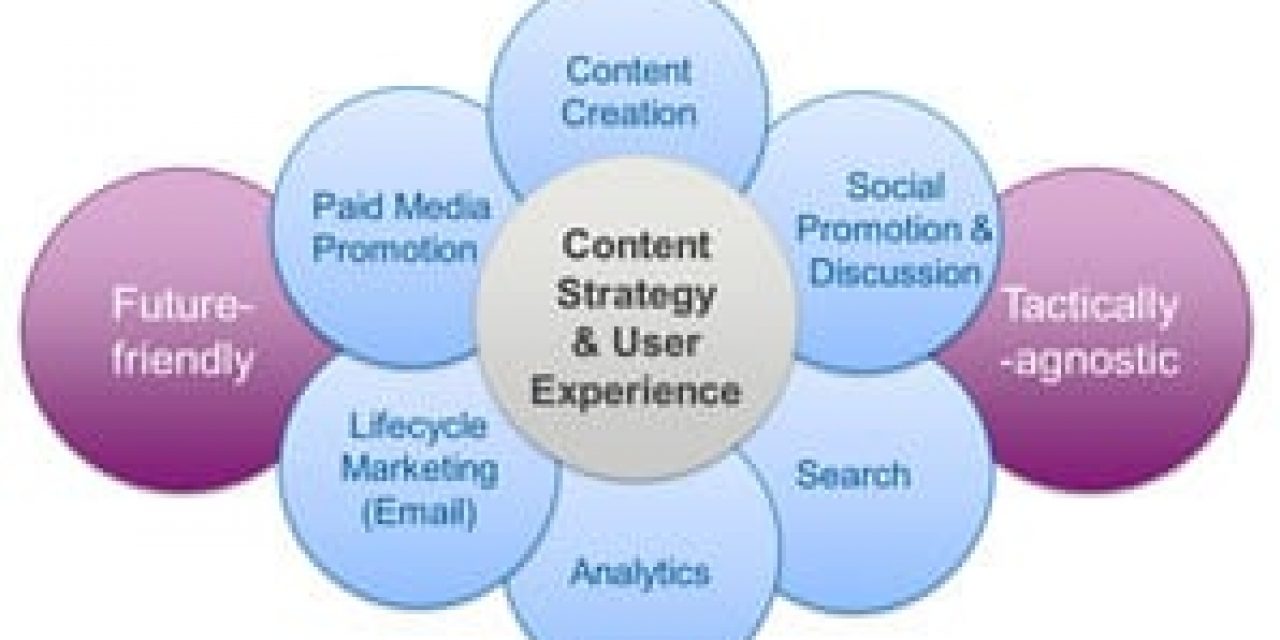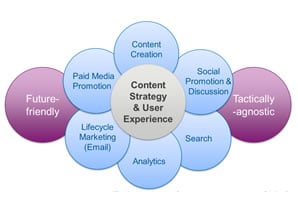
Email marketing is still the most used channel for interactions between people and companies. Yet, other channels have joined the pack and are embraced by consumers. This is not just the case in B2C or among the so-called digital natives. It’s the same in B2B and across all generations as they increasingly use digital channels.
Traditional forms of email marketing, such as e-newsletters, still have their place and email is alive and well. But it’s time to move towards a new marketing approach whereby email is part of an integrated marketing strategy. Today’s customer is channel-agnostic and he/she is at the center of sales and marketing. By now we know the key role of the overall customer experience and the customer life cycle, as well as the clear link between the creation of business value and customer value, whatever form that value takes from the customer’s perspective (remember the role of intent).
Let’s also not forget the inbound dimension of email (not in the sense of inbound marketing). Until further notice, email still ranks very high in the list of channels customers use to seek customer service. While we increasingly talk – and should talk – about the omnichannel contact center, email, the phone and paper are still very much used in this omnichannel contact center context.
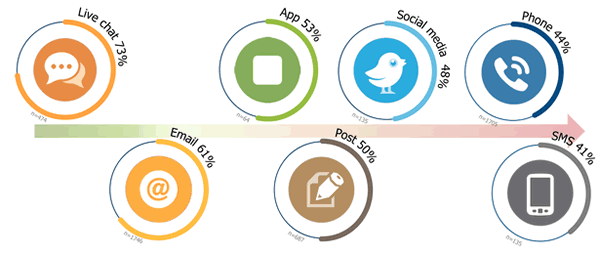
Obstacles for a more customer-oriented email marketing strategy
Back to email marketing. Communication channels are function of the customer’s preferences and marketing is about engaging the customer throughout connected interactions and “touches” that are driven by his/her buying journey, preferences, triggers, signals and behavior. Just as we did with content marketing, we like to emphasize the key role of the customer in the broadest sense in a context of a customer-centric revolution when it comes down to email marketing as well.
Email marketing may be regarded more as a series of conversations and a component of a life cycle and customer-centric approach by many businesses that are constantly improving their tactics, but these changes are often not reflected in the strategy, implementation, tools and actual execution. The reasons are both historical and structural.
Channel-centricity (and content-centricity)
We traditionally think of email marketing as a mix of outgoing and incoming messages whereby our marketing objectives, trends, events and more or less frequent emailing schemes are often central in the outgoing part.
For example, think of informative or promotional e-newsletters that are distributed with a fixed frequency or of emails that are distributed in the ambit of holidays, price reductions, product stock changes, loyalty programs etc. In this viewpoint, email is regarded as a predominantly outgoing flow of messages, more or less integrated, whereby the emails themselves and the number of recipients, opens and clicks are key.
Channel-centricity is not just happening in email marketing. It happens in many other forms of digital marketing too. Customer-centricity often turns out to be harder than said. As content marketing pioneers, we saw exactly the same happening with content-centricity, for instance, whereby a “create and distribute approach”, revolving around the content, often stood in the way of customer-centricity and still does. Funny enough, email marketing is now seen as one of the key distribution forms of content, which it is. Yet, it’s again sign of how we focus on our precious content, messages, channels and businesses, rather than connecting our goals and those of the customer in the broadest sense. A customer-centric and integrated marketing approach, with the customer and end-to-end customer experience in the center, is probably the key driver of digital transformation in a marketing context.
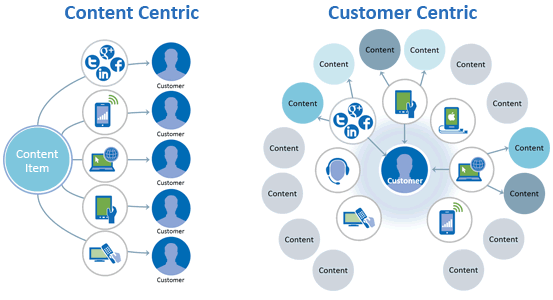
The traditional approach of email service providers
The model of most email marketing service providers (ESP) is related to this approach. They work with their customers based on (for example) the number of distributed emails and/or the number of subscribers. Not only does this pricing model strengthen our classic vision of email marketing, it also affirms an isolation of the channel email, a unilateral focus on the email campaigns and too limited a vision on the return thereof whereby tactical metrics are overemphasized.
Naturally there are circumstances and reasons to send frequent newsletters or to regard email as an outgoing flow. These depend on amongst others. the type of activities (compare the purposes of the emails from mass media to generate traffic with those of B2B companies doing lead nurturing ) and the maturity of the data model and processes. In these circumstances, segmenting, offering relevant content, personalizing and so forth, the traditional ways are clearly more important.
But, leaving aside these examples, it is time to gradually move towards a real integrated customer-centric revolution. Email marketers have to realize that the channel, the campaigns and the existing email distribution models are not the center of their universe, as their peers in other marketing ‘disciplines’ have to.
The center of the marketing universe is not even the email subscriber: it is the channel-agnostic customer and prospect in all his richness, complexity, behavior and dimensions with the buying journey and customer lifecycle as permanent beacons. This seemingly simple change of focus has many more consequences than one might think at first glance.
Consequences of a customer-driven cross-channel approach of email marketing
An email marketing approach where the customer is really central has consequences on the way in which we use email marketing, but also on the selection of the platforms and the definition of the processes and email marketing strategy. It is important to see these consequences and to take action in order to embrace a modern view of email marketing. The relevance and thus quality and frequency of interactions with (potential) customers are at stake.
If we wish to optimize and adjust our email marketing strategies to the clear and ongoing changes on the level of media consumption, purchase behavior and the changing communication reality, implementing the customer-centric view on email marketing is not optional.
The different aspects to take into account are mentioned below as well as their consequences on strategy, processes and the partners, integrations and tools that are needed.
An integrated email marketing strategy is a must
A first consequence is that email marketing is integrated by definition. The principal reason is that the online and connected customer uses various interaction channels and media to inform him, interact and share.
The way people find business and communicate with them, as well as the buying journey is non-linear and encompasses several touchpoints and media channels.
The same goes for interactions via email: they are the beginning, end or simply part of an omni-channel reality. The incoming messages or signals of the customer can happen over completely different media than the outgoing messages business sent.
All these channels should be linked and integrated as efficiently as possible to best accommodate the preferences of the customer, the marketing goals and the overall business objectives – the integration and mutual strengthening of email and social media is a typical example of this.
Furthermore, the customers must be able to interact in various ways, even if the initial interactions happened via email. This has consequences for the tools that we need to be able to implement in order to leverage this way of customer-oriented and integrated email marketing. The medium is subject to the customer and therefore channels like mobile, social and other online and offline carriers for contact opportunities should be at the disposal of the customer.
Integration in practice also implies that in the email marketing processes and strategies, the different interaction moments, irrespective of the channel or department, should be attuned on the level of frequency, timing, content, etc. to be efficient. In the customer-centric view all these crucial elements are entirely a function of the individual customer as a whole, customer experiences and touchpoints, not in function of general best practices or averages.
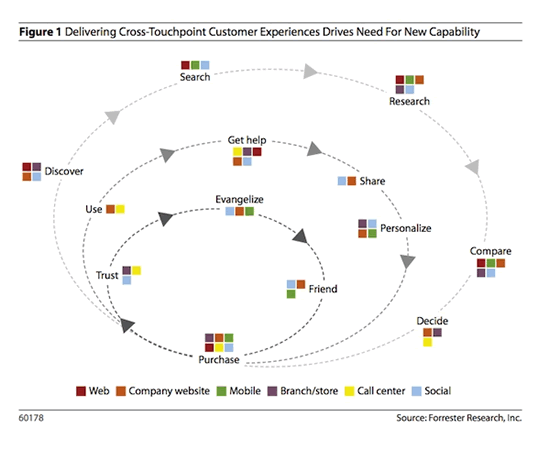
The need for a ‘closed loop’ of data and interactions
If you start from the customer instead of the media and messages, and thus by definition work in an integrated way, this impacts the way in which you measure data regarding your customer interactions. It also impacts the way in which you acquire, combine, integrate and aggregate insights about their behavior, needs and buying signals, based upon this data. The whole buying journey has to be mapped.
Most of all the data and findings you gather through a customer-centric view of your customers in email marketing and beyond, must lead to new interactions, regardless of the medium and in function of customer induced triggers. The insights we get through social media, mobile, online and offline interactions, when combined with other data sources, should lead to a single view on the customer and enable businesses to optimize all their marketing efforts. They should result in a constant optimization of the content, processes, conversion, relevance, usability, touchpoints, channels and even the overall marketing strategy, starting from a holistic and data-driven view on the customer. With big data and data-driven marketing, the stakes are even higher, especially in acting upon the single customer view and turning big data into actionable data. As such, a single customer view means nothing.
Integration with web analytics is not enough. All input that we can gather from customer touchpoints, offline included and irrespective of the channel, must lead to an improvement of the future interactions. Apart from acquiring data from cross-channel interactions, other customer data is critical in this whole process: a connection with Customer Relationship Management (CRM) applications and other customer data systems is a key to success in this regard, as is actionable data.
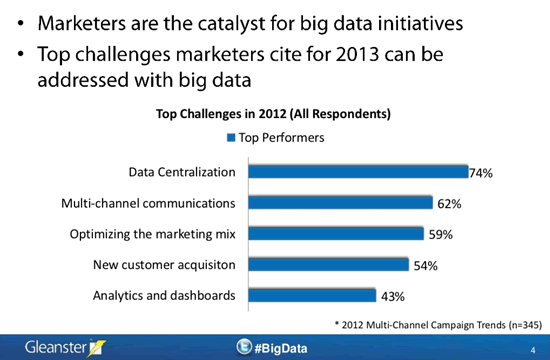
Personalize, segment and automate: triggers and scenarios
In this connected era whereby the power shifts to the customer/buyer and the customer experience is the key to future business success, the importance of human interaction is strongly emphasized.
The dream of every marketer is a one-to-one approach and for many, personal “conversations” are the way to have a competitive advantage in the connected world. Sometimes such “real” and highly personal conversations are possible and even necessary. A typical example is customer service: the customer often prefers a personal contact with an employee of a company over the time consuming experience of anonymous self-service. This of course depends on the quality of the services with which people can personally find solutions for their problems.
However, in many other situations a “real” personal interaction is nearly impossible. Is this not in contradiction with placing the customer at the center? No, because there is a difference between a personal interaction and a personalized interaction. Email marketing forms part of an entirety of incoming and outgoing interactions. In other words, two-way messaging and connecting. Sometimes these interactions can be more personal than at other times, depending on the type of communication, the medium and the objectives.
The single most important element however is that the communications have to become increasingly personalized and participative. Or to put it another way, they should be attuned as much as possible to the needs of the prospect and customer and involve them, providing a relevant cross-channel two-way interaction process. This is only one of the reasons why the closed loop of data and interactions is so important, it is also reason why this data should lead to a continuous optimizing of the relevance of the message for the individual customer. The opportunities of personalizing and segmenting that ESPs offer do help in achieving more relevance, but they are often limited and not cross-channel, integrated and bi-directional.
Furthermore, personalizing and segmenting go much further than the traditional methods of identifying and segmenting target groups depending on common characteristics from the medium point of view.
In a model where the customer is at the center, segmentation, personalization and thus relevance of communication are possible on a much more individual and optimized level since the cross-channel data and customer interactions define the what, when and even how of the email messages. By defining scenarios and triggers initiated by the customer and the actions they lead to, tracing the digital signals of the customer and putting all cross-channel interaction data to work, the pertinence of the email contact moments is optimized in every aspect.
To achieve this, automation is a requirement. It is not the opposite of personalized relevance, but what makes this relevance possible. We cannot know everyone personally and interact with them personally; advanced marketing platforms can however do that by offering a degree of personalization and value to our customers that is as “personal” as it can be. The value we offer is content, information, solutions and personalized messages in function of the triggers initiated by the customer, his buying journey, his lifecycle, interaction preferences, behavior, triggers, scenarios etc. The content, as well as the interaction frequency, timing and medium are a function of this.
Incoming is as important as outgoing
In a traditional marketing model the emphasis still mainly lies on the aspect of sending messages, even if the days of blasting are over (sending doesn’t equal blasting). As stated earlier, this is strengthened by the way in which many ESP’s and other marketing solution providers work: customers pay depending on the number of subscribers or sent emails and the focus lies on optimizing the outgoing messages. Furthermore, the most important parameters to measure impact and efficiency are related to the outgoing characteristics: how many emails or other messages were sent, how many reached the inbox, were opened etc. On the level of incoming flows and data, marketers especially look at (for example) the number of leads of the sales results of the isolated campaigns in this model. In a cross-channel and customer-centric vision this is not enough.
In a communication reality where “listening” is at least as important as “talking” in order to engage in valuable contact moments, incoming data, messages, feedback and customer-initiated interactions are the key to optimize the outgoing messages.
As stated earlier, this requires marketers to connect and integrate their different interaction channels, including email, mobile and social, and their data sources.
But there is more. In an integrated and cross-channel buying journey and marketing reality, email also is an increasingly important inbound channel. In blog marketing, search engine advertising and even display advertising and other forms of online marketing the click is a first contact that leads to a call-to-action whereby email plays an important role. The same goes for many offline campaigns, including on TV, where advertisers increasingly include an URL. Online properties, specifically landing pages, become the hub and central destination of all campaigns whereby first contacts often happen via email (for instance the download of a paper, a request for information, contact forms, etc.). These incoming email contacts are the start of a further multi-channel relationship development.
Besides email, new inbound interaction channels have shown their effectiveness (again, mainly in an integrated perspective), further strengthening the need for a cross-channel approach. Typical examples include social media with micro-blogging platforms such as Twitter that are often used to share and spread short messages with hyperlinks. But also think about web chat, for istance. In an integrated marketing approach the details regarding the way your customers interact with messages on Twitter and other communication and information channels flow back in the form of data, leading to insights, leading to actions and optimizations regarding your other marketing channels (for instance segment your email subscribers in function of their social influence, on top of their preferences).
From a cross-channel perspective, however, the main purpose is to convince people with whom information has been exchanged via social media sharing tools and call-to-actions to integrate them in an incoming stream.
The conclusion is clear: it is not only the outgoing aspect that is important, incoming interactions and data, whether it concerns the return of emails, data from web forms or behavior and interactions regarding ‘new’ media, are key; everything must be processed and used to gather cross-channel insights and provide a single customer view. The aim is to develop more personalized and relevant interactions in function of the customer as a whole.
Channel-agnostic and multi-device
Modern customers are not only channel-agnostic in the sense that they use several channels, touchpoints and media to inform themselves in all stages of their buying journey, while decreasingly distinguishing between channels, among others driven by mobile experiences.
They also use an ever growing number of devices and platforms to do so. The increasing adoption of smartphones, mobile devices such as tablets and netbooks, the growth in web-based applications to view emails, more web browsers, more operating systems etc.; the customer has more choice than ever to connect, get online and be always on.
This phenomenon is a further argument for cross-channel interactions but most of all it is another reason to make the customer central in the marketing universe. Marketers have to measure and understand the technical environments and the devices their customers use, on top of the mentioned preferences and behavior. In an online world where customer experiences travel fast and every interaction has to be valuable, business can not afford to focus on the majority of their customers alone.
From a marketing perspective this leads to the need for cross-channel tactics in function of customer preference, but also to the need to adapt messaging in regarding devices and channels. In email marketing for instance, renderability is of the utmost importance: messages and interactions must be delivered in the format that fits the devices, reading and the environments customers choose to interact in.
Tools that enable marketers to preview these emails before they are actually sent or defined in marketing scenarios, such as Litmus, are a must.
The need for integrated and customer-centric processes
When moving towards an integrated customer perspective in marketing in general, and email marketing specifically, it quickly becomes obvious that this also impacts the way businesses organize their internal processes and strategies. Email marketers, content marketers, web analytics experts, CRM practitioners, social media marketers etc. have to collaborate in order to achieve a single view and customer-centric approach.
The channel-centric way email marketing and emerging forms of marketing are looked upon, often leads to silo thinking that makes a cross-channel approach hard or even impossible.
Relatively few businesses have a centralized process for controlling their email marketing deployments, some divide it among different departments and some have no process at all, several surveys have found. Note that this just about email marketing. It is obvious that, to achieve, a true customer-centric cross-channel marketing approach, cross-divisional processes, all channels, media and marketing program “owners” have to collaborate and harmonize their customer interactions.
This way efficiency is optimized from the customer perspective, taking into account all business goals. But more importantly, in a cross-channel approach, doing this counters overlapping and poorly coordinated interactions that can lead to bad customer experiences.
In the customer-centric vision, ultimately the customer decides on timing, frequency and message in all stages of his buying journey. The processes and even organizational structures have to be built around the customer as well. Without integration or value-driven collaboration it is difficult to deliver value and engage in cross-channel dialog with the customer.
To achieve this form of collaboration and harmonize cross-channel and multi-divisional customer interactions, marketing tools, that go far beyond traditional systems such as email platforms, are required.
Digital marketing transformation: beyond customer-centricity
Implementing a full customer-centric marketing strategy for a channel-agnostic customer doesn’t happen overnight. It requires organizational changes, new processes, other tools and platforms, but most of all a new mindset whereby the customer, his buying journey, individual preferences and lifecycle take centre stage for everything we do as marketers. That’s what digital transformation in a customer experience and also a marketing context is largely about.
Engaging customers throughout connected interactions that are fully determined by their behavior and where the combination of channels is the function of his preferences and triggers, is a gradual process that needs cross-divisional collaboration and is done step by step.
Besides defining the strategy and corporate culture to embrace a true customer-centric interactive marketing approach, the key is integration. Business increasingly will need integrated marketing solutions, enabling them to have a single view on the customer and have relevant touches with them throughout the whole lifecycle and end-to-end customer experience.
Consistency and coordination across all channels are becoming essential. These shifting priorities and views are not only necessary to optimize the way we communicate, but a must in a world where the customer is empowered, in control and channel-agnostic, ever more interaction possibilities arise, big data is a fact and we’re entering stages of new technologies that will disrupt the way we interact with customers as well, such as the Internet of Things.
The time to start integrating is now.
